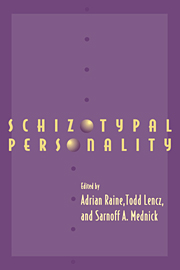Book contents
- Frontmatter
- Contents
- List of contributors
- Preface
- Acknowledgments
- Part I Introduction
- Part II Genetics and neurodevelopment
- Part III Assessment
- Part IV Categorical versus dimensional approaches
- 7 Tracking the taxon: on the latent structure and base rate of schizotypy
- 8 Detection of a latent taxon of individuals at risk for schizophrenia-spectrum disorders
- 9 Fully and quasi-dimensional constructions of schizotypy
- Part V Psychophysiology and psychopharmacology
- Part VI Neuropsychology
- Part VII Brain imaging
- Part VIII Conclusion
- Part IX Appendix
- Name Index
- Subject Index
7 - Tracking the taxon: on the latent structure and base rate of schizotypy
from Part IV - Categorical versus dimensional approaches
Published online by Cambridge University Press: 04 August 2010
- Frontmatter
- Contents
- List of contributors
- Preface
- Acknowledgments
- Part I Introduction
- Part II Genetics and neurodevelopment
- Part III Assessment
- Part IV Categorical versus dimensional approaches
- 7 Tracking the taxon: on the latent structure and base rate of schizotypy
- 8 Detection of a latent taxon of individuals at risk for schizophrenia-spectrum disorders
- 9 Fully and quasi-dimensional constructions of schizotypy
- Part V Psychophysiology and psychopharmacology
- Part VI Neuropsychology
- Part VII Brain imaging
- Part VIII Conclusion
- Part IX Appendix
- Name Index
- Subject Index
Summary
The study of schizotypic psychopathology is likely to advance our understanding of the nature of schizophrenia. One possible route of such advancement concerns clarification of the basic nature and structure of the common liability that appears to underlie both schizophrenia and schizotypic psychopathology. We shall discuss briefly the need for a latent liability construct in this area, general substantive and methodological issues relevant to the search for latent taxa (classes) in psychopathology, and our own taxometric work directed specifically toward illuminating the structure of the liability for schizophrenia. Our research in this area will be cast within the context of Meehl's (1962, 1990) model of schizotypy and schizophrenia.
We note that the terms “schizoid,” “schizotypal,” “schizotypy,” and “schizotype” have been used in a variety of ways and therefore, we provide here some orienting remarks to clarify our usage of these terms, which are by no means synonymous. In the present discussion, the term “schizotypy” refers to an underlying personality organization; it is essentially a hypothetical latent construct that cannot be observed directly. Moreover, our view is that schizotypy, by definition, embodies the fundamental liability for schizophrenia. We do not view schizotypy as a syndrome consisting of those phenotypic (directly observable) manifestations such as mildly disordered thought, peculiar use of language, interpersonal aversiveness, anxiety, odd-eccentric behavior and appearance, and so on. Rather, we prefer the term “schizotypic” (see Meehl, 1964) or “schizotypal” to describe such observable phenotypic manifestations. One can speak of a “schizotype” or a “schizotypal individual” to describe a particular person, whereas schizotypy per se is a latent hypothetical construct.
- Type
- Chapter
- Information
- Schizotypal Personality , pp. 135 - 167Publisher: Cambridge University PressPrint publication year: 1995
- 17
- Cited by

